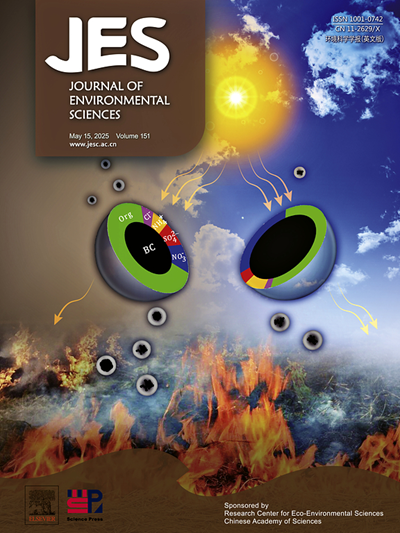平原河网流域氮损失、河流输运、湖泊积聚与水质特性的联系
IF 6.3
2区 环境科学与生态学
Q1 ENVIRONMENTAL SCIENCES
引用次数: 0
摘要
长三角地区高强度人类活动排放的各种形态的氮沿河道进入湖泊,加速了湖泊的氮循环,增加了富营养化生态风险。太湖是典型的富营养化浅湖,由于外源养分负荷过大,几十年来蓝藻大量繁殖。本研究将氮流量与外源养分负荷相结合,建立流域氮损失与湖泊响应的耦合关系。结果表明:湖泊生态系统的时空差异显著,大支流输入了大部分氮,划分为A阶段(1980—1997年),氮负荷缓慢增加;B阶段(1998-2006),尽管采取了一些控制措施,但仍有较高的氮负荷;C阶段(2007年至今)随着水危机后湖泊流域氮管理的加强,氮负荷逐渐减少,水流量逐年增加。2021年流域环境N输出量为581.46 kg/ha N,最终入湖总量为32.06 Gg N。近20年来,城市建设用地面积从8.21%显著增长到21.04%,其对城市热岛效应、路面硬化、生态脆弱性等环境影响值得关注。因此,流域的快速气候变化成为驱动支流水文条件的关键因素(r∂= 0.945)。发达的社会经济主导了污水排放(r∂= 0.857)。流域氮素的输入和损失可能会在不受控制的情况下进一步加剧。同时,湖泊会对外源输入做出响应。除湖泊自净部分外,太湖表层沉积物N积累速率为3.29 ~ 10.77 g N/(m2·yr)。为达到污染物控制目标,上游地区每年需要减少66.28 Gg左右的人为氮。厘清氮流及其环境负担可以减轻其对生态系统的破坏,并在流域尺度上进行精细化管理。本文章由计算机程序翻译,如有差异,请以英文原文为准。

Linkage between nitrogen loss, river transport, lake accumulation and water quality properties in plain river network basin
Various forms of nitrogen (N) discharged by high-intensity human activities in the Yangtze River Delta are transported into the lake along the river channel, accelerating the lake's N cycle and increasing the eutrophication ecological risk. Taihu Lake is a typical eutrophic shallow lake, suffering from cyanobacteria blooms for decades due to excessive exogenous nutrient load. In this study, the coupling relationship between basin N loss and lake response was established by combining N flow and exogenous nutrient load. The results showed striking spatiotemporal differences and the large tributaries input the majority of N. Three evolution stages of the lake ecosystem were classified, i.e., Stage A (1980–1997) with slow increasing N load; Stage B (1998–2006) with high-level N load despite some controlling methods; Stage C (2007 to present) with the strengthening of N management in lake basin after the Water Crisis, the N load has gradually decreased, while the water flow is increasing by the year. Environmental N export in the basin was 581.46 kg/ha N in 2021, and a total of 32.06 Gg N was finally drawn into the lake. Over the recent two decades, the noticeable expansion of built-up land from 8.21 % to 21.04 % associated with its environmental impacts i.e., urban heat island effect, hard pavement, and ecological fragility deserves attention. Accordingly, the rapid climate change of the basin became the key factor driving the tributaries' hydrologic conditions (r∂ = 0.945). The developed social economy dominated the sewage discharge (r∂ = 0.857). The N inputs and losses to the environment in the basin can be further exacerbated without control. Meanwhile, the lake would respond to the exogenous input. In addition to the self-cleaning part of the lake, the N accumulation rate of the surface sediment ranged from 3.29 to 10.77 g N/(m2·yr) of Taihu Lake. To meet the pollutant control target, around 66.28 Gg anthropogenic N needs to be reduced in the upper stream area yearly. Clarifying the N flow and its environmental burden can mitigate its damage to the ecosystem and take on the refined management on the watershed scale.
求助全文
通过发布文献求助,成功后即可免费获取论文全文。
去求助
来源期刊

Journal of Environmental Sciences-china
环境科学-环境科学
CiteScore
13.70
自引率
0.00%
发文量
6354
审稿时长
2.6 months
期刊介绍:
The Journal of Environmental Sciences is an international journal started in 1989. The journal is devoted to publish original, peer-reviewed research papers on main aspects of environmental sciences, such as environmental chemistry, environmental biology, ecology, geosciences and environmental physics. Appropriate subjects include basic and applied research on atmospheric, terrestrial and aquatic environments, pollution control and abatement technology, conservation of natural resources, environmental health and toxicology. Announcements of international environmental science meetings and other recent information are also included.
 求助内容:
求助内容: 应助结果提醒方式:
应助结果提醒方式:


